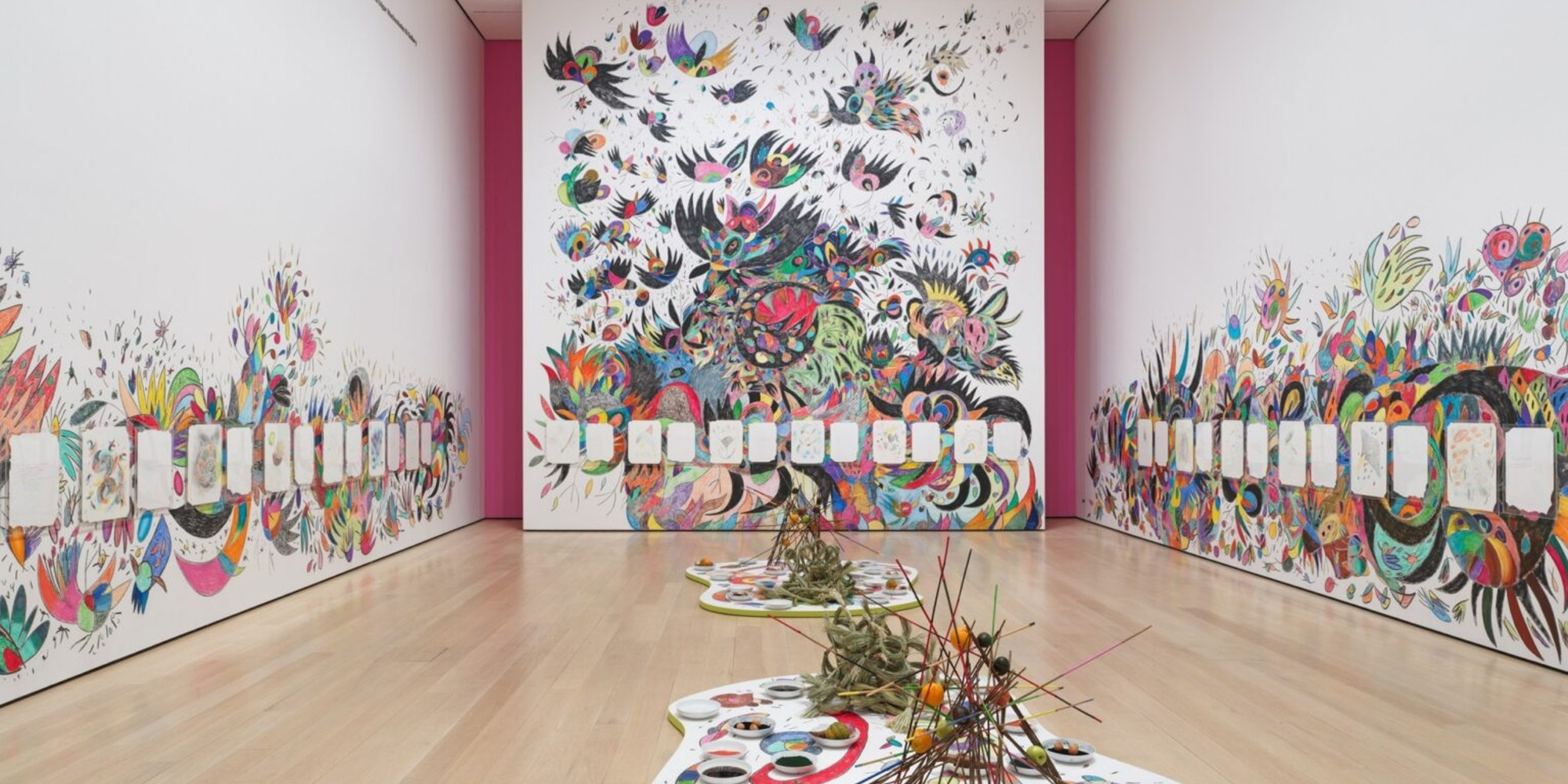
The Artistic Journey of Tadáskía
Explore the transformative work of an artist committed to illustrating the power of imagination and collective liberation.
Tadáskía
Jun 6, 2024
My name is Tadáskía. I was born in 1993 and grew up in Santíssimo, on the outskirts of Rio de Janeiro. My entire life I’ve studied in public schools and public universities, where I’ve had diverse contacts with the artistic world. From the age of 12 to the age of 19, I attended pentecostal churches, where I experienced spontaneous dance, music, and theater. At the age of 18, I entered the State University of Rio de Janeiro through a government scholarship given to Black and low-income people.
Me chamo Tadáskía, nasci em 1993 e cresci em Santíssimo, uma periferia do Rio de Janeiro. Tenho estudado a minha vida toda em escolas e universidades públicas, por onde tive contatos diversos com o mundo artístico. Dos meus 12 anos aos meus 19 frequentei algumas igrejas evangélicas, por onde convivi com a dança espontânea, com a música e com o teatro. Aos 18 anos ingressei na Universidade Estadual do Rio de Janeiro, por meio de bolsa governamental dada às pessoas negras e de baixa renda.
When you enter this exhibition, you will experience three works that speak to each other, but have different stories. First, the drawing animated play III, which is made with charcoal and dry pastel. Second, the bilingual book consisting of 61 loose pages called ave preta mística mystical black bird. And the last is arrangement, a diptych of sculptures made with dried plants, bamboo, beads, colored powders, eggs drawn with golden thread, amongst other things—all on platforms with charcoal and dry pastel drawings.
Ao entrar na sala de exposição, você pode experienciar três trabalhos, os quais conversam entre si, mas com histórias diferentes. Primeiro, o desenho brincando animada III, feito com carvão e pastel seco; segundo, o livro bilíngue, de 61 páginas soltas, ave preta mística mystical black bird; e por último o arranjo, um díptico de esculturas feito com plantas secas, bambu, miçangas, pós coloridos, ovos desenhados com linha dourada, entre outras coisas sobre plataformas desenhadas com carvão e pastel seco.
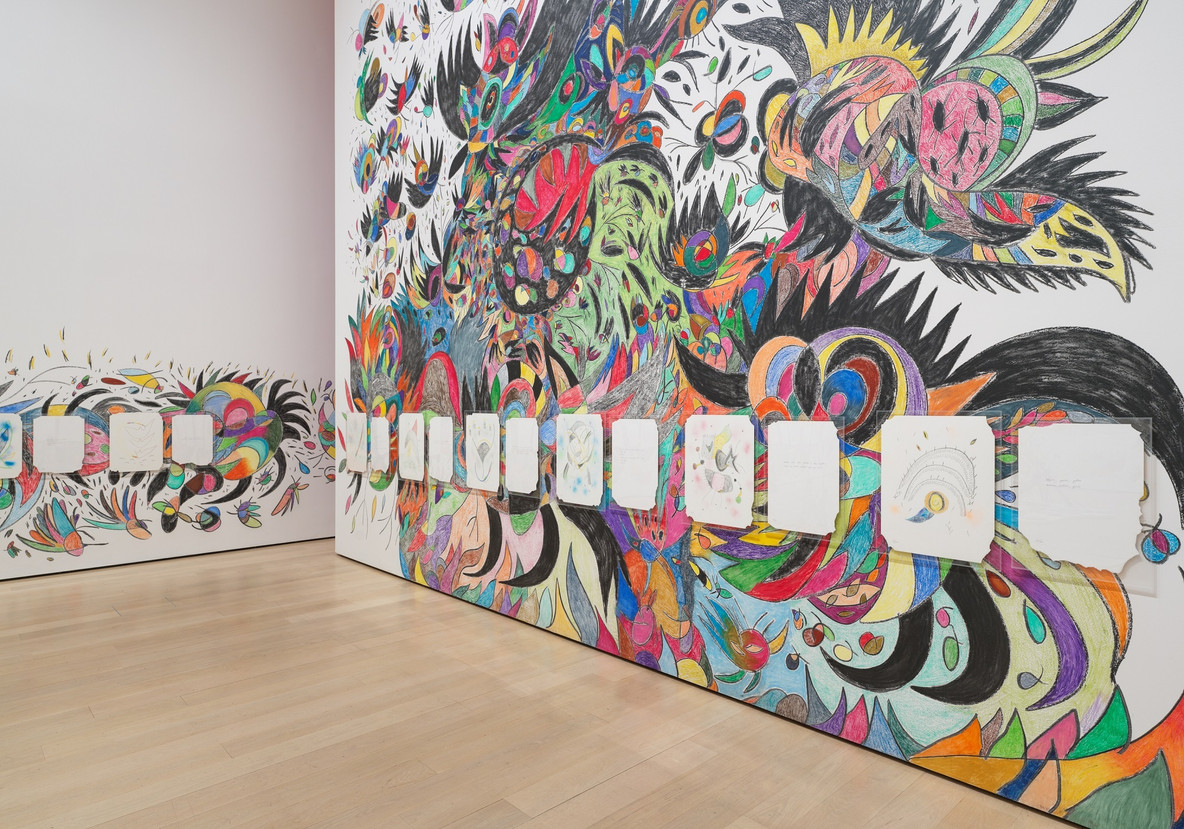
Installation view of Projects: Tadáskía at MoMA
My works have affinities between themselves, while also revealing and hiding differences in their creation stories. For example, I began coming into contact with arrangements through cattails, when, in 2017, I was working as an educator at the MAR (Rio Museum of Art). The museum was throwing away a lot of cattail mats, and I took some of them to sleep on at home. Later, I reencountered cattails in 2019, when another art institution, Parque Lage, was also discarding the material. In this way, my first arrangements began by playing with lines of straw, creating loose arrangements without tying wire, and using materials that would otherwise be discarded. I began, afterwards, to tie the arrangements with wire, later adding bamboo, semi-precious stones, plates with colored powders, dark chicken eggshells, fruits, vegetables, among other things that might occur to me.
São trabalhos com afinidades entre si, ao mesmo tempo que revelam e escondem diferenças nas suas histórias de criação. Por exemplo, eu comecei a ter contato com os arranjos através da taboa, quando eu trabalhava no Museu de Arte do Rio (RJ, Brasil) enquanto educadora, em 2017. O museu estava jogando fora muitas esteiras de taboa, e eu levei algumas para dormir sobre elas em casa. Depois, reencontrei as taboas outra vez em 2019, quando outra instituição de arte, o Parque Lage (Rj, Brasil), igualmente descartava o material. Dessa maneira, meus primeiros arranjos começam comigo brincando com as linhas que a palha aparenta, sem amarração de arame, arranjos soltos, de materiais que iriam para o lixo. Começo por conseguinte a amarrar os arranjos com arame, seguindo com o acréscimo de bambu, pedras semi-preciosas, pratos com pós coloridos, cascas de ovos escuros de galinha, frutas, legumes entre outras coisas que podem surgir.
Drawing and writing are old interests of mine. As a child, I loved cartoons, including the crazy, old version of Woody Woodpecker. My mother said that in order for me to watch this cartoon, she needed to close up the entire house, which at the time was just one room, so that the light wouldn’t invade the screen of the old tube television. It was necessary to stay in the dark so the cartoon could appear. Then, between the ages of 11 and 12, I was hospitalized due to a bacterial infection that covered half of my face. It was there, at the hospital, that I met a nurse who dressed up as a clown to cheer up the children and tell stories every afternoon. When I was discharged from the hospital, the clown gave me a series of books of La Fontaine’s fables. I never saw these books again, only as a child, and then I lost them. However, from then on, when I was 13, 14 years old, I started writing constantly on a computer that was so old it gave me shocks. The desire to write possessed me even more consciously than the act of drawing. That’s because I’ve been drawing since I was very little, on the floor of the house, on the doors and walls. Drawing has always been with me unconsciously. At that time, writing became my curious way of trying to tell the world my most hidden feelings.
Desenhar e escrever são interesses meus antigos. Quando criança eu amava desenho animado, inclusive a versão mais maluca e antiga do Pica-Pau. Minha mãe me dizia que para eu conseguir ver esse desenho animado ela precisava fechar toda a casa, que era na época um cômodo só, para que a luz não invadisse a tela antiga da televisão de tubo. Era preciso ficar no escuro para que o desenho animado pudesse aparecer. Depois, entre meus 11 e 12 anos de idade, fiquei internada por conta de uma bactéria que tomou metade do meu rosto; foi ali no hospital que conheci uma enfermeira que se vestia de palhaça para animar as crianças e contar histórias toda tarde. Quando eu fiquei de alta hospitalar a palhaça me deu um grupo de livros das fábulas de La Fontaine. Nunca mais revi esses livros, só na infância, depois os perdi. No entanto, a partir daí, com meus 13, 14 anos começo a escrever constantemente em um computador velho que me dava choque. A vontade de escrever me possuía de maneira até mais consciente do que o ato de desenhar. Isso porque eu desenho desde muito pequena, no chão da casa, pelas portas e paredes. O desenho sempre esteve até de maneira inconsciente comigo. Naquela época, escrever passou a ser minha forma mais estranha de tentar dizer para o mundo, o que eu sentia de mais oculto.
My work is made for the interior world, the familiar, as well as for everything that is foreign, distant, for everything that is beyond my domain and my control.
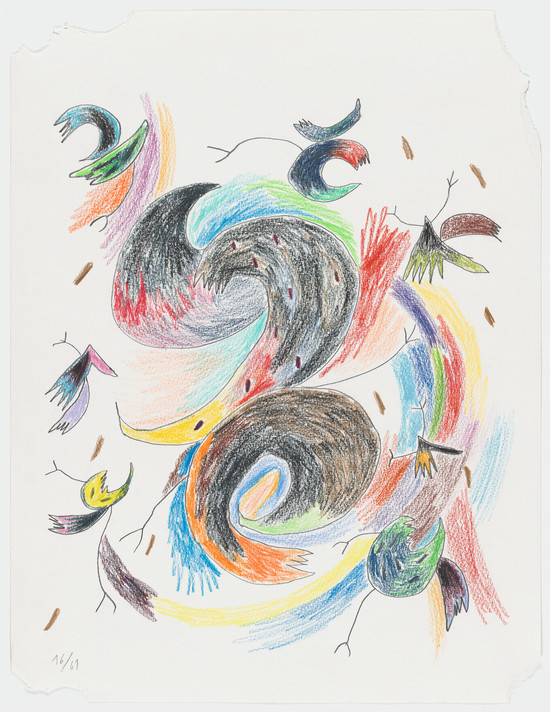
Tadáskía. ave preta mística mystical black bird. 2022
In 2022 I went through some existential challenges at the same time that I had my first opportunity to cross the Atlantic. I saw night turn to day as I crossed the skies and seas. When I arrived in Barcelona I stayed in a square called Ocellets which, in Catalan, means “little birds.” When I returned to Brazil, I remembered Sankofa’s appearance when I was 18 years old, at a welcome conference for scholarship students at UERJ. Soon after, I remembered Sankofa in the window grilles commonly present in houses in the outskirts of Rio de Janeiro. I had already drawn many chickens before, enchanted chickens, winged animals, mystical beings with wings. However, in 2022 the ave preta mística mystical black bird came to me, inviting me to imagine not only individual liberation but also shared liberation.
Em 2022 passei por alguns desafios existenciais ao mesmo tempo que tive minha primeira oportunidade de atravessar o Atlântico. Vi a noite virar dia ao cruzar os céus e os mares. Quando cheguei em Barcelona fiquei em uma praça chamada Ocellets que, em Catalão, significa passarinhos. Ao voltar para o Brasil lembrei da aparição de Sankofa quando eu tinha 18 anos, em uma conferência de boas vindas aos estudantes cotistas na UERJ. Logo depois relembrei de Sankofa nas grades que formam as janelas, presentes comumente nas casas do subúrbio do Rio de Janeiro. Eu já havia desenhado antes muitas galinhas, frangas encantadas, bichos alados, seres místicos com asas. No entanto, em 2022 a ave preta mística chegou até mim, me convidando a imaginar uma libertação não apenas individual como também compartilhada.
I started making ave preta mística mystical black bird initially through drawings. I made all the drawings to then write the poetic texts; I started drawing freely, and that’s how the story began to emerge. I shuffled the first drawings with the last ones. In this same way, the text that starts the book is not necessarily what was done first. The beginning, the middle and the end are continually confused in my story.
Comecei a fazer ave preta mística mystical black bird primeiramente pelos desenhos. Eu fiz todos os desenhos para depois fazer os textos poéticos; fui desenhando livremente, e assim a história começou a surgir. Eu embaralhei os primeiros desenhos com os últimos, do mesmo jeito que o texto que inicia o livro não é necessariamente o que foi feito primeiro. O início, o meio e o fim se confundem continuamente em minha história.
It’s ambiguous, because imagination can carry me beyond myself. I believe that there is a divine power in the act of creating, a mystery that involves us in the journey from “here to there,” something that is within myself but is not reduced to me. My work is made for the interior world, the familiar, as well as for everything that is foreign, distant, for everything that is beyond my domain and my control.
É ambíguo, porque a imaginação consegue me levar para além de mim. Eu acredito que exista um poder divino no ato de criar, um mistério que nos envolve na travessia do “aqui para o lá”, algo que está comigo mas não se resume a mim. Meu trabalho é feito para o mundo interno, familiar, como também para tudo que é estrangeiro, distante, para tudo que está além do meu domínio e do meu controle.
In ave preta mística mystical black bird the drawings were made with graphite, colored pencils, oil pastel, and spray on paper and the text was just graphite on paper.
Em ave preta mística mystical black bird os desenhos foram feitos com grafite, lápis de cor, pastel oleoso e spray sobre papel e a parte textual apenas grafite sobre papel.
In the book it is possible to see that the drawing does not explain the text, in the same way that the text does not explain the drawing. I believe it is one more story of free interpretation between one thing and another, a dance made between distances and proximities.
No livro é possível perceber que o desenho não explica o texto, da mesma forma que o texto não explica o desenho. Acredito que seja mais uma história de interpretação livre entre uma coisa e outra, uma dança feita entre distâncias e proximidades.
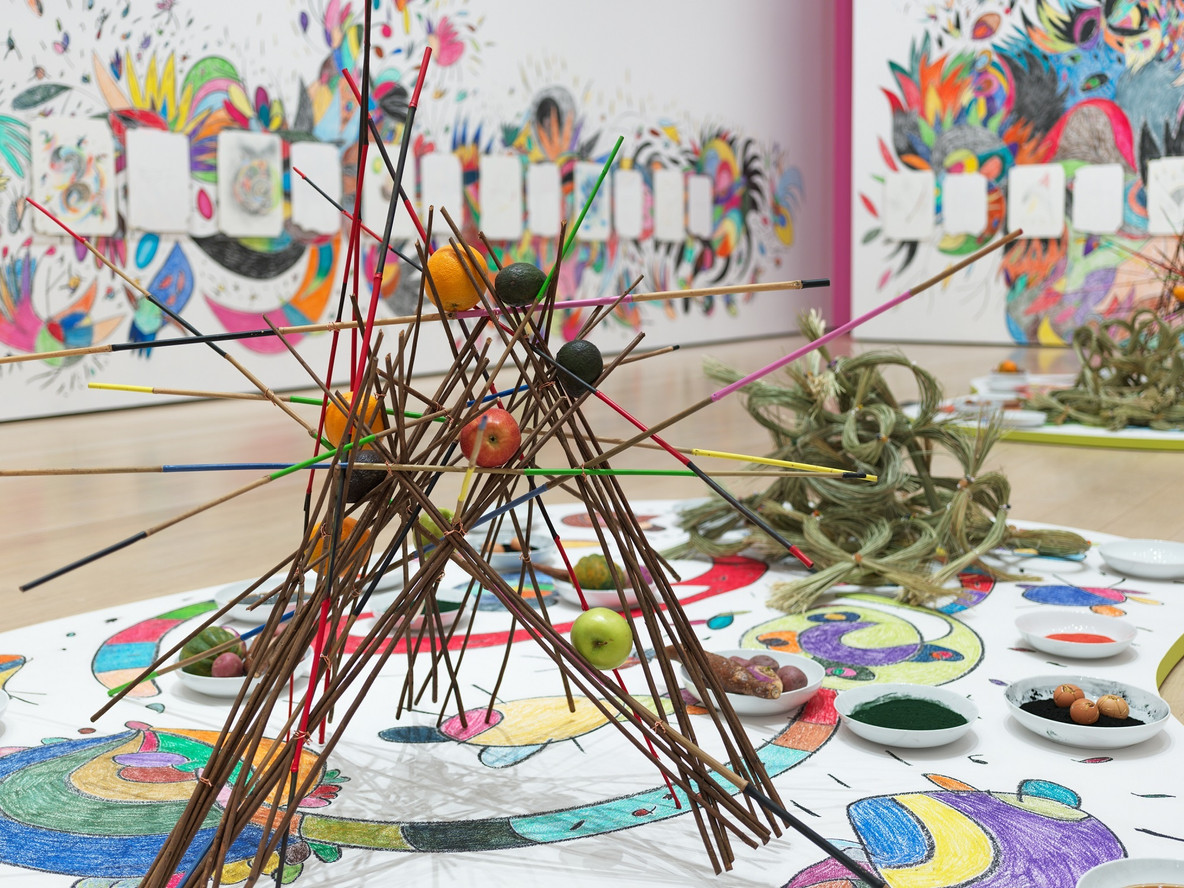
Projects: Tadáskía
The name “mystical black bird” came through the realization that a flight doesn’t just happen in the physical world: a flight can happen through something visible or invisible, grand or subatomic.
The name “mystical black bird” came through the realization that a flight doesn’t just happen in the physical world: a flight can happen through something visible or invisible, grand or subatomic. A flying being, in my imagination, gives us a sense of freedom when finding and losing itself. Soon after naming the book I discovered that the word “mystical” can even mean “that which has its eyes closed.” In this way, a mystical black bird can fly to hidden dimensions, singing freely within and without our known time.
O nome ave preta mística veio por eu perceber que um voo não acontece apenas no mundo físico: um voo pode acontecer por uma coisa visível ou invisível, grandiosa ou subatômica. Um ser voador, na minha imaginação, confere a nós um sentido de liberdade ao se achar e ao se perder. Logo depois de nomear o livro descobri que a palavra mística pode inclusive significar “aquilo que está de olhos fechados”. Dessa maneira, uma ave preta mística pode voar até as dimensões ocultas, cantando livre dentro e fora do nosso tempo conhecido.
I often start some of my drawings with my eyes closed. When I imagined the book ave preta mística mystical black bird, I came across a distant and familiar connection between the black bird and Sankofa, who could equally be “neighbors” to each other, or friends, or perhaps beings with some contact in the world of imagination. As I mentioned before, I met Sankofa briefly when I was 18 years old and years later I noticed its shape in windows and doors around Rio de Janeiro. Now I know about its relationship with the funeral, when reading about the Adinkras, ideograms of the Akan people - the Adinkras are also a farewell from the soul, a farewell towards the spiritual plane. Sankofa reminds us that it’s not a taboo to pick up something that is at risk of being left behind; with Sankofa, with the mystical black bird and with other enchanted chickens and birds, the present time continues flying towards multiple directions of the future.
Frequentemente inicio alguns dos meus desenhos de olhos fechados. Quando imaginei o livro ave preta mística mystical black bird me veio uma conexão familiar distante entre a ave preta e Sankofa, podendo ser igualmente “vizinhos” um do outro, ou amigos, ou quem sabe seres com algum contato no mundo da imaginação. Como disse antes, conheci Sankofa quando eu tinha 18 anos, de maneira breve, depois de anos percebi sua forma em janelas e em portas pelo Rio de Janeiro. Agora sei da sua relação com o funeral, ao ler sobre os adinkras, ideogramas do povo Akan - os adinkras são também um adeus da alma, um adeus em direção ao plano espiritual. Sankofa nos lembra que não é um tabu pegar algo que está em risco de ser deixado para trás; com Sankofa, com a ave preta mística e com outras frangas encantadas e aves, o tempo presente segue voando para as múltiplas direções do futuro.
As a child I drew on fresh cement with my sister, as well as doodled on the bathroom doors and the walls of my parents’ house. Then, when I was older, I returned to the act of drawing on the floor, with charcoal and dirt, as well as drawing on the backs of women in my family. With charcoal and pastel I started to make a small drawing in an art gallery in Barcelona. Soon after, for the first time, I made a drawing going from floor to ceiling, in a circular room at the São Paulo Biennial; and I drew on a half-moon shaped wall at the Oscar Niemeyer Museum. In these last experiments I had done it by myself and God, but at MoMA, for the first time, I have five assistants who work with me filling the color of the shapes that I’ve created. With the participation of Karen del Aguila, Antônia Bara, René Dominguez, Nereida Patrícia and Anthony Rosado, at MoMA, I see the drawing emerging as a children’s coloring book: one through which we fill with color shapes that were already made by someone else. So, even though I give certain guidelines, such as freely choosing colors or even placing a certain color here and another there, I exercise less control when each assistant chooses the color that the shape can have. I feel that by giving my assistants certain openings to choose colors, I give the drawing a feeling closer to spontaneity.
Quando criança eu desenhava no cimento fresco com a minha irmã como também rabiscávamos as portas do banheiro e as paredes da casa dos meus pais. Depois, mais velha, retomei o ato de desenhar pelo chão, com carvão e terra, como também fiz um desenho nas costas das mulheres da minha família. Com carvão e pastel comecei a fazer um desenho pequeno em uma galeria de arte em Barcelona, logo depois fiz pela primeira vez um desenho indo do chão ao teto, em uma sala circular na Bienal de São Paulo; e desenhei uma parede no formato semi-lua no Museu Oscar Niemeyer. Nessas últimas experiências eu havia feito sozinha e Deus, porém no MoMA, pela primeira vez, tenho assistentes que me auxiliam a colorir as formas criadas por mim. Com a participação de Karen del Aguila, Antônia Bara, René Dominguez, Nereida Patrícia e Anthony Rosado, no MoMA, percebo o desenho surgindo tal como um livro de colorir infantil: aquele pelo qual preenchemos de cores as formas já feitas por alguém. Assim, ainda que eu dê certas orientações, tais como escolher livremente as cores ou mesmo colocar uma certa cor aqui outra acolá, eu faço um exercício de perder o controle, quando cada assistente escolhe a cor que a forma pode acontecer. Sinto que ao dar essa abertura de escolha das cores às assistentes, entrego ao desenho uma sensação mais próxima da espontaneidade.
Making mistakes and getting things right is part of the drawing condition. Making mistakes and getting things right is part of the human condition. Humanizing drawing is humanizing life. Because I can’t completely distinguish between what has gone right and what was a mistake. Drawing is very similar to love: if you want to control too much it won’t give you the intimate and inherent feeling of freedom. Drawing for me always has an ambiguous energy: it is ugly and beautiful, right and wrong, here and there. From drawing, I learn to desire the spontaneity of life. And when I feel like my desire for control is getting too close to my drawing, I close my eyes. For me, it has been beautiful to watch the five assistants coloring animated play III, because when I see them coloring I notice many color paths that I would not have chosen if I were coloring the drawings by myself.
Errar e acertar faz parte da condição do desenho. Errar e acertar faz parte da condição humana. Humanizar o desenho é humanizar a vida. Até porque eu não consigo distinguir totalmente até onde vai o acerto e por onde passa o erro. Desenhar é bem parecido com o amor: se você deseja controlar demais ele não te dará a sensação íntima e inerente de liberdade. O desenho para mim tem uma energia sempre ambígua: ele é o feio e bonito, o certo e o errado, o aqui e o lá. Aprendo com o desenho a desejar a instância mais espontânea da vida. E quando sinto que meu desejo de controle está se aproximando demais do meu desenho, eu fecho os meus olhos. Para mim tem sido lindo observar as cinco assistentes colorindo “brincando animada III”, porque ao vê-las colorir eu percebo muitos caminhos de cor que sequer eu escolheria se eu estivesse colorindo os desenhos sozinha.
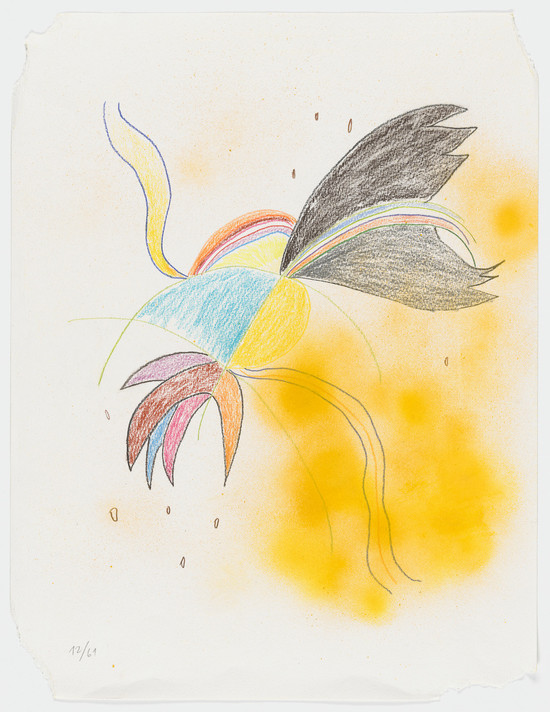
ave preta mística mystical black bird
May everyone feel free to interpret my work based on their own sensibility. And with luck, I hope my work takes anyone who desires it to a mystical world, the realm of love and of imagination, where change is possible and welcome.
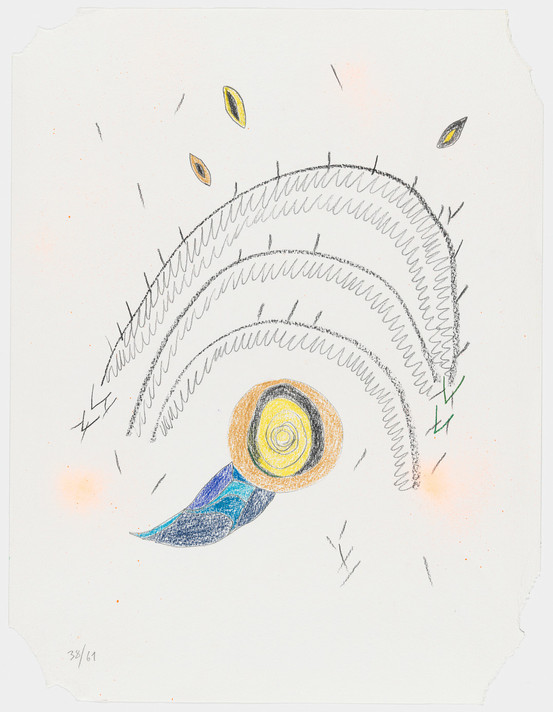
ave preta mística mystical black bird
Nature is in everything; leaving it means being faced with another world, another understanding of language. Leaving human nature means entering the spiritual realm, the afterlife, etc. I like to envision imagination as the entry and exit of nature, the entry and exit of life, the entry and exit of what is known. The mystical world, the spiritual, the realm of love, of illusions, passions, fantasies and desires run through this known nature and also leads us to navigate in a total lack of knowledge. In ave preta mística mystical black bird it is possible to see this flight that enters and leaves human nature. In fact, at the end of the book, we hear the bird’s voice admit “the constituent error of every flight,” and so it redraws the routes of its sensitivity over again. There is something human and divine in us as well as in the mystical black bird and, through this union, making mistakes in flight allows us to continually redraw the nature of our sensitivity.
A natureza está em tudo, sair dela é estar diante de outro mundo, de outra compreensão da linguagem. Sair da natureza humana é entrar no terreno espiritual, do pós-vida etc. Gosto de vislumbrar a imaginação enquanto a entrada e a saída da natureza, a entrada e a saída da vida, a entrada e a saída do que é conhecido. O mundo místico, espiritual, o reino do amor, das ilusões, das paixões, fantasias e desejos percorrem esta natureza conhecida, como também nos levam a navegar em um total desconhecimento. Em ave preta mística mystical black bird é possível ver esse voo que entra e sai da natureza humana. Inclusive, no final do livro, ouvimos a voz da ave dizer que admite “o erro constituinte de todo o voo”, e assim ela redesenha as rotas da sua sensibilidade outra vez. Tem algo de humano e divino em nós como também na ave preta mística e, por essa junção, errar um voo nos permite continuamente redesenhar a natureza da nossa sensibilidade.
In addition to drawing, I work with other mediums, and whenever it is possible I allow myself to mix them. I really believe that the conversation between sculpture, drawing, video, photography, text, and so on, brings out the similarities and differences between one thing and another. With energies that can contradict, or luckily, complement each other. In any case, I like to imagine that, with some risk, the work will be read beyond my control. Now, for the exhibition at MoMA, the arrangement offers some evidence of the general condition of chronological time. It is one that alters everything: fruits, vegetables, chicken eggshells, liquids, dried plants, bamboo, wire, body and face powder...all these elements surrender themselves in a singular and indiscriminate way to time. All beings of this known nature yield their bodies to time. The drawing on the wall is no different: we see this temporary character, perhaps in a more subtle way: the inevitability of no longer existing in the same way it was born: the transformation of materials, in addition to the destruction, or better yet, the constancy of change itself.
Além do desenho, eu trabalho com outras mídias, e sempre que possível me permito misturá-las. Acredito bastante na conversa entre escultura, desenho, vídeo, fotografia, texto e assim por diante, fazendo emergir as semelhanças e as diferenças entre uma coisa e outra. Com energias que, inclusive, podem se contradizer, ou por sorte, se complementar. Gosto de todo modo imaginar que, com algum risco, o trabalho seja lido para além do meu controle. Agora, para a exposição no MoMA, o arranjo oferece alguma evidência da condição geral do tempo cronológico. Este que altera todas as coisas: as frutas, os legumes, as cascas de ovos de galinha, os líquidos, as plantas secas, o bambu, o arame, o pó de corpo e de rosto… todos esses elementos se entregando de maneira singular e indiscriminada ao tempo. Todos os seres dessa natureza conhecida cedem seu corpo ao tempo. Com o desenho na parede não é diferente: vemos esse caráter temporário, talvez de maneira mais sútil: a iminência de não existir mais da mesma forma que nasceu: a transformação dos materiais, além disso a destruição, ou melhor, a mudança sempre inerente dentro de si.
May everyone feel free to interpret my work based on their own sensibility. And with luck, I hope my work takes anyone who desires it to a mystical world, the realm of love and of imagination, where change is possible and welcome.
Que todas as pessoas sintam-se livres para interpretar meu trabalho a partir da própria sensibilidade. E com sorte, desejo que meu trabalho leve quem quiser para um mundo místico, o reino do amor e da imaginação, onde a mudança é possível e bem-vinda.
As told to Arlette Hernandez, Associate Educator, Interpretation, Research, and Digital Learning
Projects: Tadáskía is on view at MoMA through October 14, 2024.

